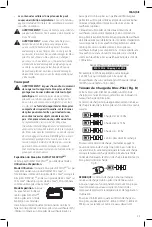
English
13
the battery foot up.
Positioning the nailer this way
makes the jammed pin or pieces of the pin more likely
to be ingested into the nailer. If any portion of a pin is
ingested into the tool, the pin should be retrieved by
removing the top cap.
If a pin becomes jammed in the nosepiece, keep the tool
pointed away from you and follow these instructions
to clear:
1. Remove battery pack from tool and engage trigger
lock-off.
2. After laying the tool on its side, slide the spring-loaded
pusher latch
15
to the base of the magazine to lock it
into place and unload pin strip.
3. Rotate the magazine release lever
14
and rotate the
magazine
12
forward.
Fig. K
4. Remove jammed/bent nail, using pliers if necessary. The
contact trip can be removed if necessary. Refer to
To
Replace Contact Trip
.
CAUTION:
If any portion of a pin is ingested into
the tool, the pin should be retrieved by removing the
top cap.
5. If the driver is in the down position, rotate the stall
release lever on the top of the nailer.
nOTE:
If the driver will not reset after rotating the stall
release lever, manually resetting the blade with a long
screw driver may be necessary.
6. Rotate the magazine back into position under the nose
of the tool and close the magazine release lever.
7. Reinsert battery pack.
nOTE:
The tool will disable itself and not reset until the
battery pack has been removed and reinserted.
8. Reinsert pins into magazine (Refer to
Loading the Tool
).
9. Release the pusher latch.
10. Disengage the trigger lock-off when ready to
continue nailing.
nOTE:
Should pins jam frequently or the driver continually
fail to reset, have tool serviced by an authorized
D
e
WALT
service center.
Cold Weather Operation
When operating tools at temperatures below freezing:
1. Keep tool as warm as possible prior to use.
2. Actuate the tool 10 or 15 times into scrap lumber
before using.
Hot Weather Operation
Tool should operate normally. However, keep tool out of
direct sunlight as excessive heat can deteriorate bumpers
and other rubber parts resulting in increased maintenance.
MAINTENANCE
WARNING: To reduce the risk of serious personal
injury, turn unit off and remove the battery pack
before making any adjustments or removing/
installing attachments or accessories.
An
accidental start-up can cause injury.
DAILY MAINTENANCE CHART
ACTION
Clean magazine, pusher, and contact
trip mechanism.
WHY
Permits smooth operation of magazine,
reduces wear, and prevents jams.
HOW
Blowing off the tool with compressed air is
the most effective way to clean the tool. The
use of oils, lubricants periodically or solvents
is not recommended as they tend to attract
debris and/or damage the plastic parts of
the tool.
ACTION
Before each use, check to ensure all screws
and fasteners are tight and undamaged.
WHY
Prevents jams and premature failure of
tool parts.
HOW
Tighten loose screws using the appropriate
hex wrench or screwdriver.
Cleaning
WARNING:
Blow dirt and dust out of all air vents with
clean, dry air at least once a week. To minimize the risk
of eye injury, always wear ANSI Z87.1 approved eye
protection when performing this.
WARNING:
Never use solvents or other harsh
chemicals for cleaning the non-metallic parts of
the tool. These chemicals may weaken the plastic
materials used in these parts. Use a cloth dampened
only with water and mild soap. Never let any liquid
get inside the tool; never immerse any part of the tool
into a liquid.
Lubrication
NOTICE: NEVER
spray or
in any other way apply
lubricants or cleaning
solvents inside the tool.
This can seriously affect
the life and performance of
the tool.
D
e
WALT
tools are properly lubricated at the factory and are
ready for use. However, it is recommended that, once a year,
you take or send the tool to a certified service center for a
thorough cleaning and inspection.
Содержание DCN891
Страница 59: ......
















































